‘Our children came home with moccasins’
Beaded moccasins confiscated from a Native boy at the Carlisle school more than 100 years ago finally return to their homelands
Charles Fox
ICT

Kelley Bova, right, receives a hug after speaking to a group of elders at the Lake Traverse Reservation in South Dakota on Sept. 23, 2023. Bova, Sisseton Wahpeton Oyate, brought home a pair of moccasins that had been confiscated from a Native boy at the Carlisle Indian Industrial School in Pennsylvania more than 100 years […]
WARNING: This story contains disturbing details about residential and boarding schools. If you are feeling triggered, here is a resource list for trauma responses from the National Native American Boarding School Healing Coalition in the U.S. In Canada, the National Indian Residential School Crisis Hotline can be reached at 1-866-925-4419.
The moccasins sat for decades in the corner of a glass-enclosed bookcase in Pennsylvania, nestled on a shelf with a Davy Crockett trading card and Canadian Mountie knick-knack.
They had long been separated from the unknown Native boy who had worn them into the notorious Carlisle Indian Industrial School more than 100 years ago, where they were taken from him along with his Native connections to family, language and traditions.
By the time they returned quietly home to Sisseton Wahpeton Oyate lands in late September, however, their anonymity had made them universal, a reminder of the forced assimilation that had formed the mission of the Pennsylvania school.
“It’s all about those moccasins,” said Tamara St. John, a Sisseton Wahpeton Oyate historian and South Dakota state representative. “They are the symbol of everything that happened there.”
Their journey home – accompanying the remains of two Sisseton and Spirit Lake boys repatriated to their tribes and families – brought not only another step toward reconciliation and healing for those involved but also inner peace and a sense of purpose to others along the way.
Moccasin tracks
The skilled craftsmanship of the moccasins’ quill and beadwork apparently caught the attention of seamstress Susan Zeamer, who worked at the Carlisle school from 1895 to 1908.
At some point, she took them home for herself. Whether she slipped the moccasins into her pockets or was given permission to keep them is lost to history.
The moccasins were then passed down through generations until a great-nephew by marriage, John Baker, 72, now of Buckingham Township, Pennsylvania, became their owner in 2011.
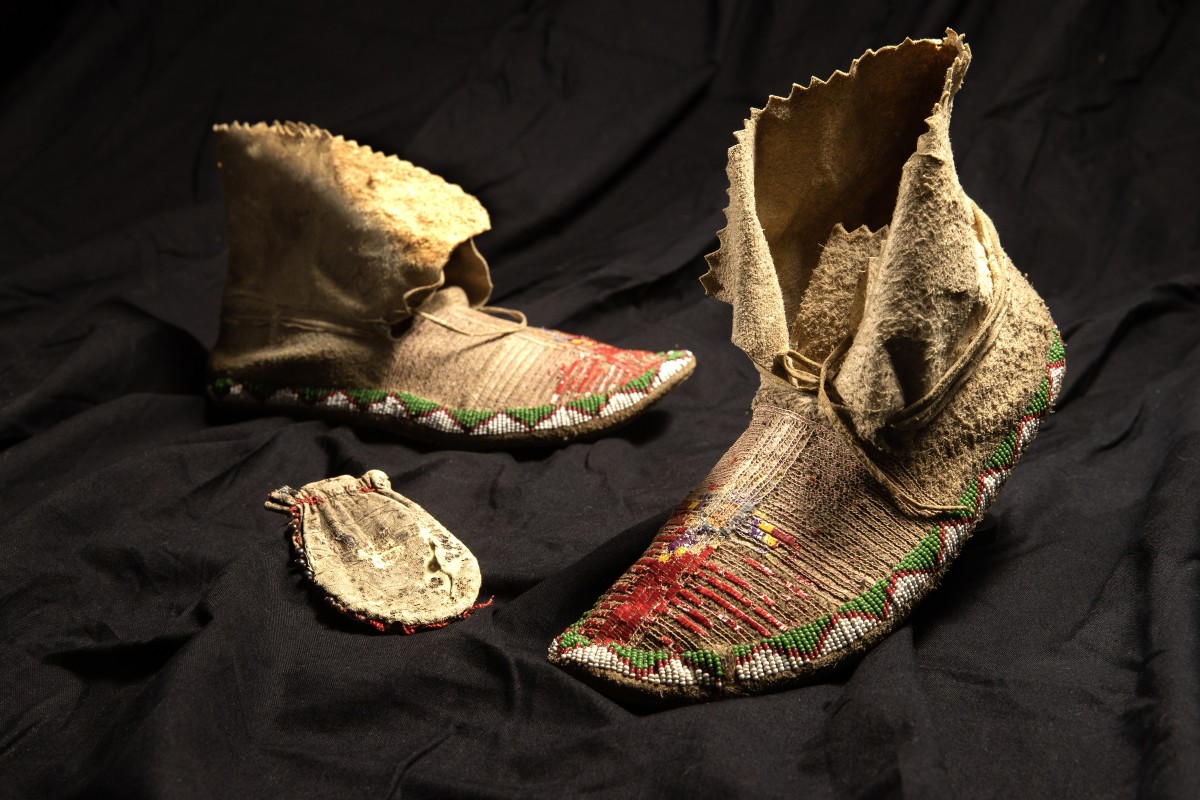
Baker remembers being fascinated by the moccasins in the bookcase in his parent’s home as a boy in the 1950s, when Westerns were popular on television and movie screens. He visualized a young Indigenous boy wearing them on adventures.
Over the past decade, however, despite the sentimental attachment, Baker became uneasy with possessing them. Like many who grew up in the Carlisle area, Baker’s knowledge of the Carlisle school was limited, but being the owner of the moccasins had enlightened him to the reality of the harsh history of the school and the treatment of Indigenous children. He felt a new responsibility. He understood the moccasins were not his to keep, but his quest to find their home of origin was filled with frustrations.
Museums and tribes did not always reply to his queries, but his research convinced him the moccasins were Plains Indian in style.
He finally reached out to Arla Patch, in Bucks County, Pennsylvania, a founding member of the Coalition of Natives and Allies advocacy, group which has led a fight against Native mascots. He showed her the moccasins on a Zoom call and told her of his desire to see them returned.
“I was getting pretty frustrated,” Baker said. “What’s going to happen to these? … They’re more than just an artifact, they’re actually part of a lineage that still is alive and well.”
Patch introduced him to her close friend, Kelley Bova, a fellow member of the Coalition of Natives and Allies, who is Dakota.
Bova, too, had been removed from her culture and traditions. Born in Sisseton, South Dakota, she was adopted as a 3-month-old infant by a White family and grew up far from her Native relatives.
Independent research with tribal historians and museum experts confirmed the moccasins were Plains Indian in style, though a specific tribe could not be pinpointed. Officials with the Blackfeet, Dakota, and Rosebud Sioux tribes all felt they were characteristic of their style.
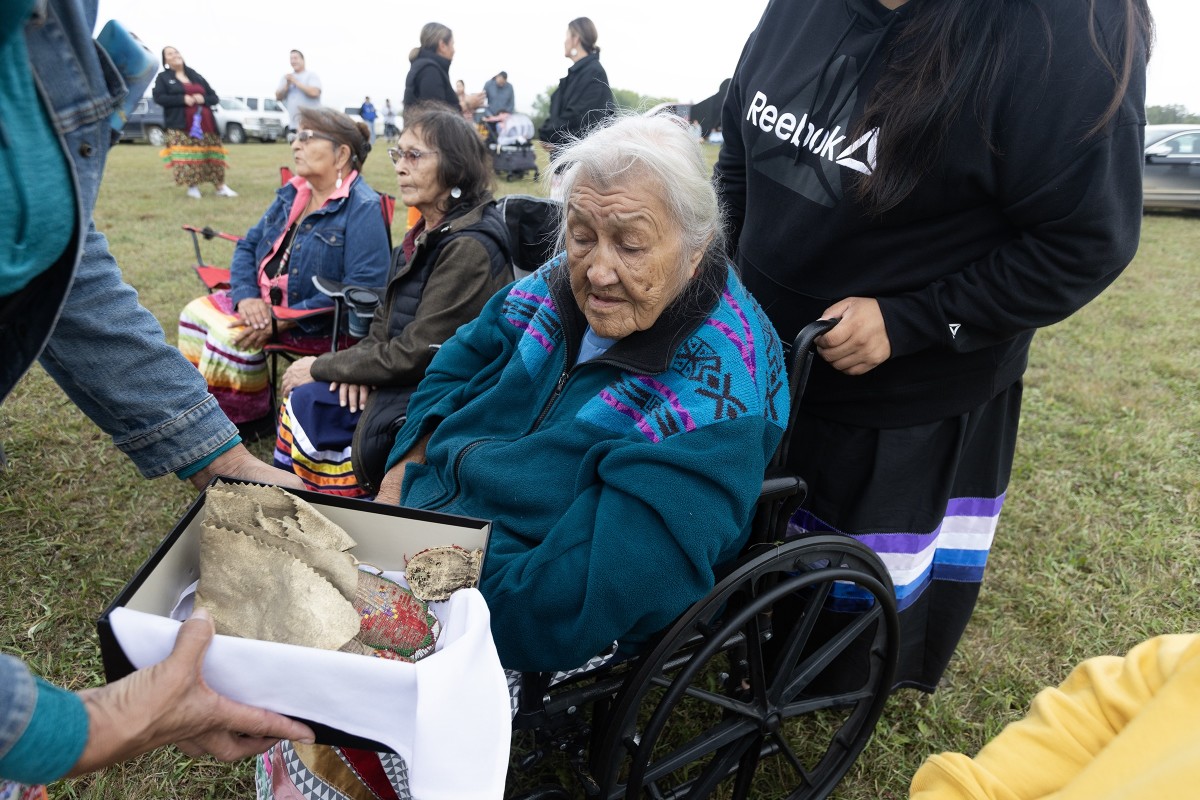
Bova believed her own tribe, the Sisseton Wahpeton Oyate, should take the moccasins, and tribal officials agreed. Bova was tapped as the proper person to deliver them to their symbolic home.
“I find it mystical that Kelley and my path would cross, and that John’s and my path would cross,” Patch recalled. “It’s just so amazing. You couldn’t write a script like this.”
Baker presented the moccasins to Bova in November 2022, at Peace Valley Park in Bucks County. He said he felt both a void and a peace to no longer have them in his home in the antique bookcase that he inherited along with the moccasins.
“It was really strange to not have the moccasins in the bookcase anymore,” he said recently. “They’ve been there my whole life. I kind of lost this imaginary friend. But I can’t tell you how much peace that brought me. There was a real sense of well-being about it. Something definitely was settled.”
A different era
While Baker felt the absence, Bova quickly formed a close bond with the worn, leather shoes. They had been on similar journeys, more than a half-century apart, and Bova felt it was time to take them home.
“I would actually talk to them, tell them that they were safe now,” Bova said, as she waited to take the moccasins to Sisseton. “I have prayed with them, and I treat them like a child. I take care of them and plan to be able to bring them home.”
Finding your way home is something Bova knows about.
Her journey began as Rose Anne Owen, a Dakota infant taken from her family at birth and moved to Rosebud to await adoption. At age 3 months, she was placed into the hands of Salvatore and André Petrilli, a suburban Philadelphia dentist and his wife. The Glenside couple, of Italian and Irish descent, had struggled to have their own biological children and had arranged for the adoption through Catholic Charities.
Rose made her 1,900-mile journey to Glenside, Pennsylvania, and was renamed Kelley Elizabeth Petrilli. A new birth certificate was created to reflect that she was the child of two Caucasian parents. Her American Indian heritage was wiped away on paper. A Montgomery County Orphans Court clerk, ironically with the last name of Custer, gave the final stamp of approval to the adoption.
She had become a child of the Native adoption era, a decades-long forced assimilation of Native children established under the Indian Adoption Project, which started in 1958 and evolved to include 50 private and public placement agencies across the United States and Canada.
By then, boarding schools had proven to be expensive and unsuccessful. Adoption was the new attempt at assimilation, but the expenses would be the responsibility of the adopting parents and not that of the government. Raised in a White home, without the communal support of other students, adoption was viewed as a more successful tool for assimilation.
In the next 20 years, until the Indian Child Welfare Act ended the adoption project, almost 13,000 Native children were adopted. Native children are still four times more likely to be removed from their families and placed in foster care than non-Native children.
Love without identity
Unlike many other adoptees, Bova did not suffer a childhood of abuse. The Petrillis provided a loving, middle-class home and private schools, while never hiding her Native heritage.
Eventually, they would have five biological children on their own, but Bova always knew she was different, a Native island in an ocean of White suburbia.
“You’re an Indian, you’re an Indian,” one of her cousins would taunt.
“No, I’m not,” she would scream back, a denial that still embarrasses her and causes her pain today.
“When I was younger, I wanted to be White; I still feel guilty about that,” Bova told The Philadelphia Inquirer in 2021. “I just wanted to fit in and be like my sisters. … I did not like being tall and brown and different.”
For Bova, that feeling of isolation led to what she calls her “dark years” after high school.
“Deep down, when you are adopted, you have a wound inside yourself,” she said. “If your parents gave you up, how lovable can you be?”
Sandy White Hawk, a Sicangu Lakota from Rosebud, knows the feeling. She was adopted at 18 months, and grew up to found the First Nations Repatriations Institute. She currently works at the Indian Child Welfare Act Law Center in Minneapolis.
“Even in loving families, Native adoptees live without a sense of who they are,” White Hawk told the Inquirer. “Love doesn’t provide identity.”
Bova, now 60, did not find her way back to her biological mother, Lillian Owen, and siblings, or her Dakota tribe, the Sisseton Wahpeton Oyate, until she was 50. Like students who attended Native boarding schools, she found herself split between two worlds and not fitting completely in either.
“When any child was taken, they were also not able to continue their journey of being Native American. We were robbed of our identity,” said Bova, who is now an enrolled member of the tribe. “I think that’s the hardest part for me to sometimes wrap around, that you’re robbed of that. And people don’t understand that, but I’m … grateful that I found my family and I try to learn as much as I can.”
Patch said the journey continues.
“Kelley does not have her Whiteness, and she does not have her Nativeness,” Patch said of her friend. “The healing power of Kelley’s story is that she is now getting to be Dakota. She’s getting to connect with that Dakota heritage.”
Rose’s story
On Memorial Day weekend in 2021, Kelley made her first visit to the former grounds of the Carlisle Indian Industrial School, drawn by a group of Native women and others from the Circle Legacy group who clean and decorate the graves each year.
She stood in the Indian Cemetery on a raw, rainy day with the white gravestones laid out in front of her in perfect rows, like desks in a classroom.
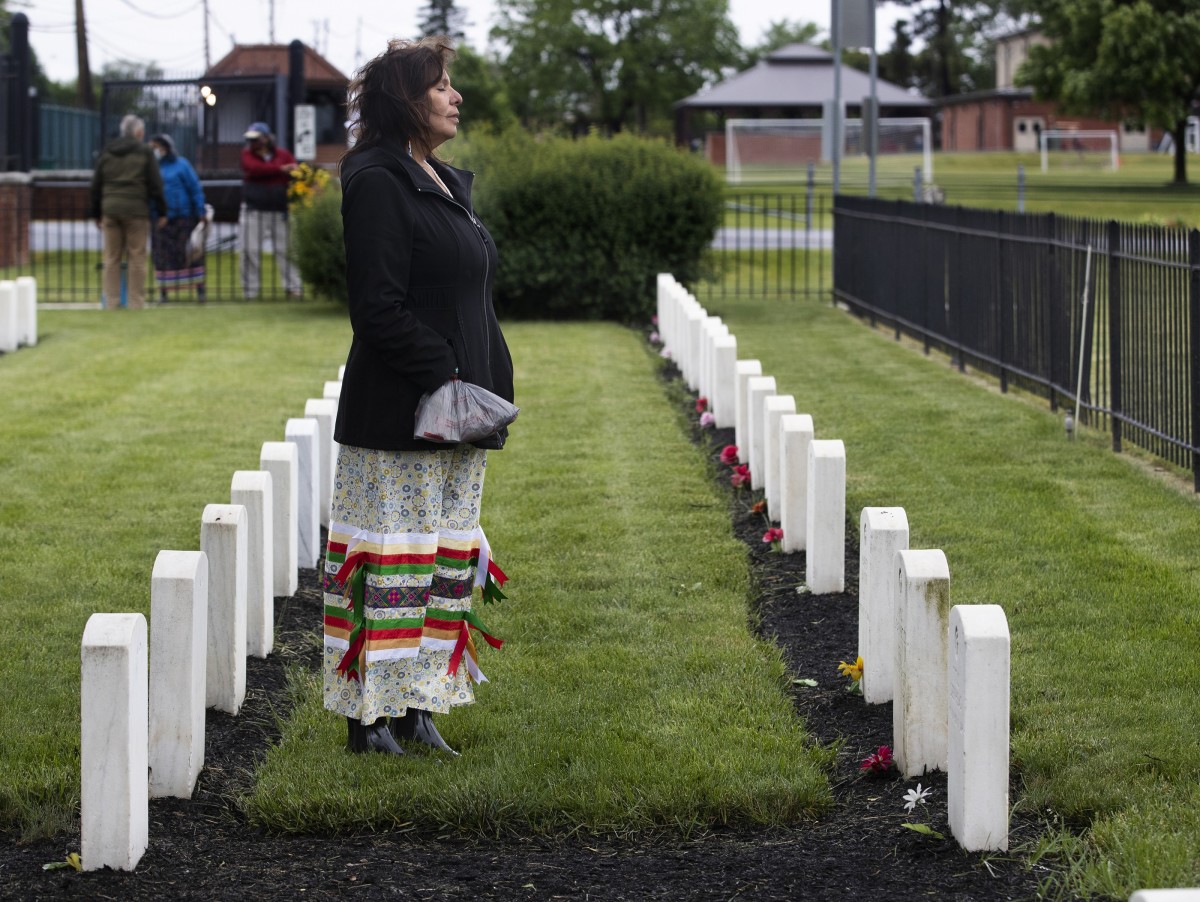
They marked the remains of the students who had died while attending the school but had not been returned home to their families. Most were victims of diseases such as tuberculosis.
Her eyes became transfixed on one particular grave. The gravestone simply read “Rose, Sioux.” It was the name she had been given by her biological parents.
“Just seeing that grave with her name, my name on it,” Kelley later said, “it just made me cry.”
It was the grave of Rose Long Face, also known as Little Hawk, Rosebud Sioux, who was among the initial group of 84 students to arrive at the school on Oct. 6, 1879. She died 18 months later on April 29, 1881.
Their journeys had been separated by 84 years but were nonetheless similar. Both had made the journey from Rosebud to a Pennsylvania town, to have their Native identities removed and be renamed in the process. Both had been separated from their families and the land that should have been their home by a government assimilation program.
Bova moved a few rows over and found the graves of two other Dakota students, Amos LaFromboise and Edward Upright. She knelt, placing tobacco bundles on their graves, speaking softly to let them know they were not forgotten and one day they would be home again.
Rose Long Face made it home first, however. In the summer of 2021, she was among nine Rosebud students repatriated from the cemetery to their homeland in South Dakota. She had been away 140 years.
Amos and Edward
Amos and Edward began their journeys home in September 2023, when they were disinterred from the Carlisle cemetery in a private ceremony that included tribal members, ancestors and others.
Their homecoming provided a chance to return the moccasins, as well, to Sisseton.
Amos and Edward were among six Sisseton Wahpeton Oyate/Spirit Lake students, four boys and two girls, who arrived at the Carlisle school on Nov. 6, 1879, along with seven students from other tribes. They arrived exactly one month after the first group of students had walked through the gates.
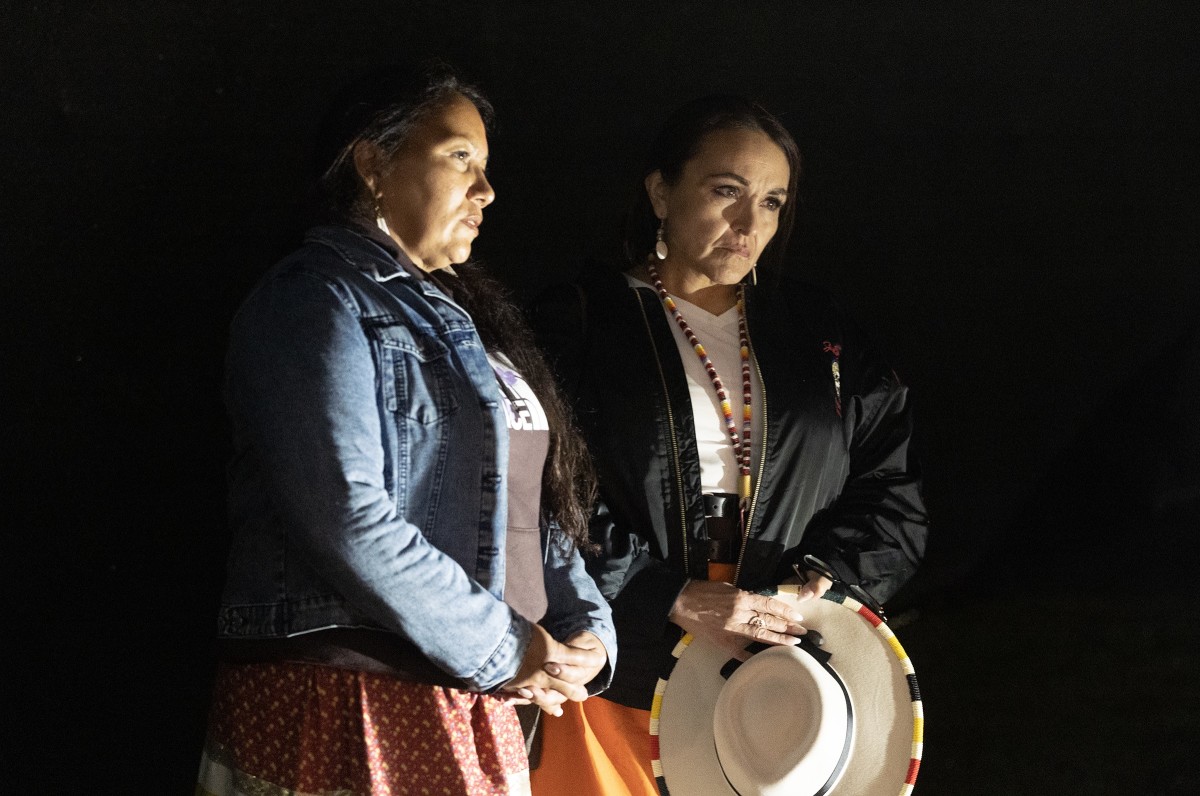
In 20 days, Amos was dead — the first student to die at the school. There is no record of the case of death, though a newspaper report at the time suggested he was sick when he arrived at the school.
Edward, son of Chief Waanatan II, was 12 when he arrived at the school, a year younger than Amos. He died on May 5, 1881, of pneumonia as he was recovering from measles.
Amos and Edward were among four students disinterred from Carlisle in September as part of the U.S. Army’s disinterment project at the Carlisle Barracks. The others, Beau Neal, Northern Arapaho, and Launey Shorty, Blackfeet, were also returned to their tribes and families.
Amos and Edward were taken by a caravan of nine passenger vans and vehicles that left Carlisle on the afternoon of Sept. 19 for the 22-hour drive to Sisseton.
Along the way, the caravan stopped in Ohio to pick up two more remains being returned by Oberlin College. Two additional remains, believed to be about 500 years old, were already waiting for burial in South Dakota after being returned by a North Dakota coroner’s office.
Amos and Edward arrived on Sept. 20 at the site of the former Sisseton Agency, where they had last said goodbye to their parents. This time, however, they were greeted by about 100 people gathered in celebration.
They were then taken to the Sisseton Wahpeton Oyate repatriation grounds to complete the traditional four days of mourning before a private ceremony and burial at the repatriation cemetery. The other four remains were also buried at the repatriation cemetery.
Bova made the same journey with the moccasins tucked inside a shoebox, boarding the caravan at Carlisle for the trip to Sisseton.
For her, the trip was an opportunity to take part in an historic moment for the Sisseton Wahpeton Oyate and Spirit Lake people, but also an opportunity to continue her healing process. She had visited Sisseton more than 10 times in the past 10 years for Sundances, powwows, and family events.
“It’s like there’s this vessel and this wound and every time [I go to Sisseton] it gets filled a little more, then a little more and a little more,” Bova said afterward. “That’s why it helped doing this. Because that was able to fill [the void] even more. Fill that wound up and heal it.”
During the final three days of mourning at Sisseton, with ceremonies at sunrise and sunset, gatherings with food, and conversations with elders, Bova experienced events she had missed for 50 years. This was especially true of her time spent with the Buffalo Heart women.
“Those Buffalo Heart women allowed me to help with the remains,” she said. “That was such a gift to me.”
‘These are my people’
On Saturday, Sept. 23, the day of burial for Amos and Edward, about 100 people of all ages stood on the hillside overlooking the open graves.
The remains were taken down from a wooden scaffold and eventually bundled in buffalo robes along with a star quilt, moccasins, and other traditional items brought by relatives. They were then placed in their graves with the love and respect that should have been afforded them as the sons of chiefs.
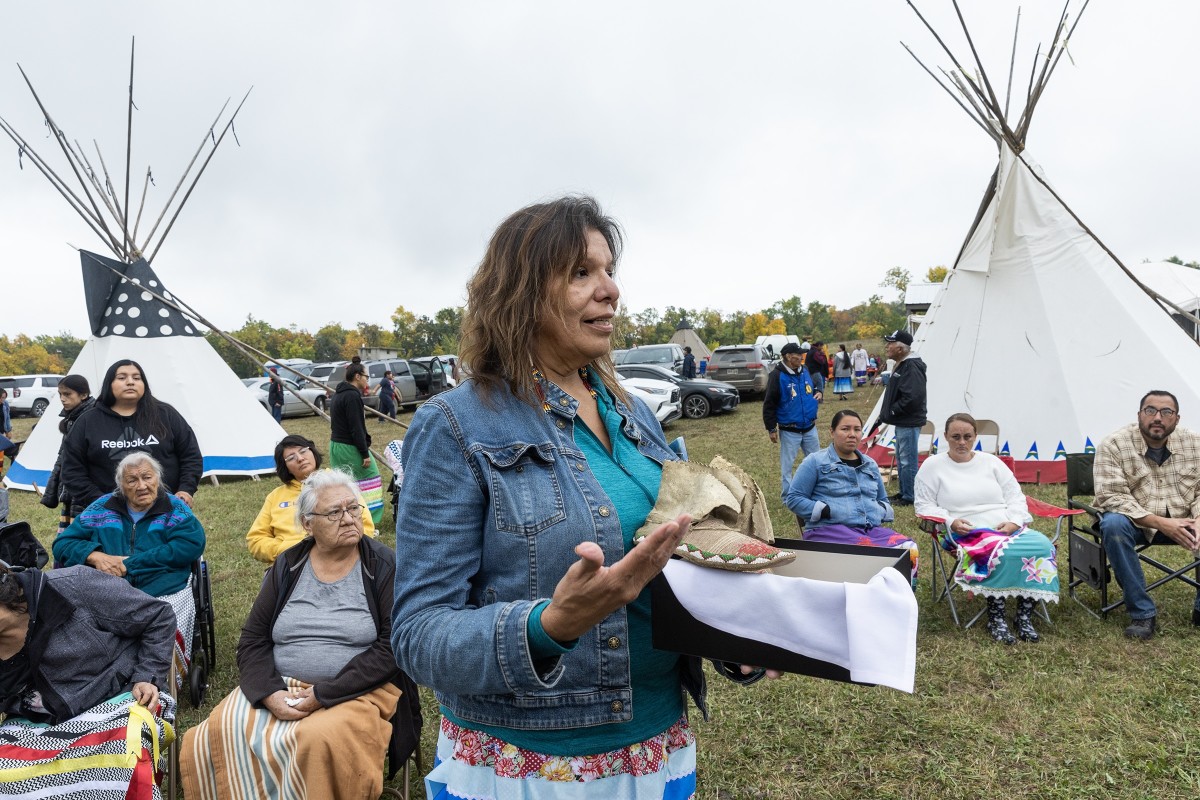
“Whenever I am in the teepees, by the fire, and hearing the men drumming and singing, it takes me back to another time,” Bova said. “It’s something that makes me feel so special. …That’s my DNA; that’s my heritage. Not knowing it for 50 years and finally seeing things like that, it has a healing power inside of me that helps a lot. Seeing all of this, I come to the realization that these are my people. This is who I am… The biggest thing I have learned is to let go of how I was raised as opposed to who I really am.”
Then it was Bova’s turn to address the group. She spoke to a gathered group of elders at the front of the crowd where they could see the moccasins she held in her hands.
She told the story of the moccasins and their pathway to her, and then presented them to tribal chairpersons J. Garret Renville of the Sisseton Wahpeton Oyate and Lonna Street of Spirit Lake, as well as historian St. John.
“It’s a privilege to be able to do this,” she told ICT. “And it’s a very spiritual thing. Because I feel like it’s my journey home, and now I can help these moccasins go home. I know they’re just a thing. But to me, there are symbols of every child that was taken, whether it was through adoption or through the residential schools. I think it’s just so important that these go home.”
Upon hearing the news of the moccasins’ return to the Dakota people, Baker responded from his Pennsylvania home that he felt “ relief, peace, and closure” and “a sense of gratification that comes with complete accomplishment.” The endeavor had taken over a century but was finally achieved.
St. John has big plans for the moccasins.
“I could build a museum around the moccasins to forever tell the stories of so many — past, present, and future,” she said. “I want them to be representative of our children and their journey home. I want them to represent how the federal assimilation tactics of places like Carlisle did not win.”
The moccasins can tell that story, she said.
“Our boys will be here and laid to rest on the homelands and protected ever on, but those moccasins will sit in their place in our collections with their story,” St. John said.
“To ‘keep one’s moccasins’ is said to mean that a Native person did not give up their traditional way,” she said. “Our children came home with moccasins.”






